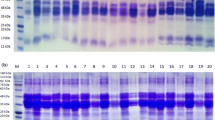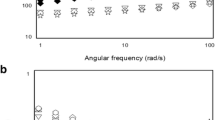Abstract
Gluten can trigger allergies or celiac disease in sensitive individuals. This study reports the effects of Bifidobacterium longum, Lactobacillus acidophilus and Lactiplantibacillus Plantarum (each strain at 109 CFU/ml of dough) on the gluten hydrolysis of wheat. The selected strain mixture was used to evaluate and compare the chemical properties of the fermented dough after 24, 48, and 72 h. Gliadin concentration was estimated by bicinchoninic acid assay, and the presence of gliadin was confirmed by sodium dodecyl sulfate–polyacrylamide gel electrophoresis. Fermentation decreased protein, ash, and pH and increased moisture content significantly (P < 0.05). HPLC peaks showed the content of different gliadin monomers decreased after 72 h fermented. A certain peak exists, while the amount was related to the gliadin content and depended on the time of probiotic exposure. This reduction of protein may be due to the synergistic effect of protease secretion by mixed Lactobacilli and Bifidobacteria, responsible for gliadin degradation. These changes in protein by mixed culture proteolysis of probiotics were confirmed by SEM by observing small particle gliadin peptides. Moreover, changes in the viscoelastic properties of fermented dough mixed with probiotics were studied by rheometry. The rheological data indicated a higher storage modulus (G′) compared to loss modulus (G″) in control compared with fermented dough with probiotics. The tan δ of dough treated with probiotics significantly increased after the time of incubation. Further studies are needed to improve its organoleptic properties.







Similar content being viewed by others
Data availability
Not applicable.
Notes
De Man, Rogosa and Sharpe agar.
References
S. Mezaize, S. Chevallier, A. Le-Bail, M. De Lamballerie, Gluten-free frozen dough: Influence of freezing on dough rheological properties and bread quality. Food Res. Int. 43(8), 2186–2192 (2010)
G. Czaja-Bulsa, M. Bulsa, Adherence to gluten-free diet in children with celiac disease. Nutrients 10(10), 1424 (2018)
D. Gayathri, A. Ramesha, Gluten-hydrolyzing probiotics: an emerging therapy for patients with celiac disease. World Acad. Sci. J. 2(5), 1–1 (2020)
R. Duar, K. Clark, P. Patil, C. Hernández, S. Brüning, T. Burkey et al., Identification and characterization of intestinal lactobacilli strains capable of degrading immunotoxic peptides present in gluten. J. Appl. Microbiol. 118(2), 515–527 (2015)
A.M. Chander, H. Yadav, S. Jain, S.K. Bhadada, D.K. Dhawan, Cross-talk between gluten, intestinal microbiota and intestinal mucosa in celiac disease: recent advances and basis of autoimmunity. Front. Microbiol. 9, 2597 (2018)
U.K. Laemmli, Cleavage of structural proteins during the assembly of the head of bacteriophage T4. Nature 227(5259), 680–685 (1970). https://doi.org/10.1038/227680a0
M. Gobbetti, C.G. Rizzello, R. Di Cagno, M. De Angelis, How the sourdough may affect the functional features of leavened baked goods. Food Microbiol. 37, 30–40 (2014)
N.G. Heredia-Sandoval, M.Y. Valencia-Tapia, A.M. Calderón de la Barca, A.R. Islas-Rubio, Microbial proteases in baked goods: modification of gluten and effects on immunogenicity and product quality. Foods 5(3), 59 (2016)
E. Abedi, K. Pourmohammadi, M. Sayadi, Synergic effect of phytase, amylase, galactosidase, and asparaginase activity on the mitigation of acrylamide and hydroxymethylfurfural in roll bread by co-culture fermentation. J. Food Compos. Anal. 106, 104355 (2022). https://doi.org/10.1016/j.jfca.2021.104355
C.G. Rizzello, J.A. Curiel, L. Nionelli, O. Vincentini, R. Di Cagno, M. Silano et al., Use of fungal proteases and selected sourdough lactic acid bacteria for making wheat bread with an intermediate content of gluten. Food Microbiol. 37, 59–68 (2014)
R. Di Cagno, M. De Angelis, P. Lavermicocca, M. De Vincenzi, C. Giovannini, M. Faccia et al., Proteolysis by sourdough lactic acid bacteria: effects on wheat flour protein fractions and gliadin peptides involved in human cereal intolerance. Appl. Environ. Microbiol. 68(2), 623–633 (2002)
Y. Hamid, L. Tang, M.I. Sohail, X. Cao, B. Hussain, M.Z. Aziz et al., An explanation of soil amendments to reduce cadmium phytoavailability and transfer to food chain. Sci. Total Environ. 660, 80–96 (2019)
Y. Wang, P-M. Jodoin, F. Porikli, J. Konrad, Y. Benezeth, P. Ishwar, CDnet 2014: An expanded change detection benchmark dataset. In: Proceedings of the IEEE Conference on Computer Vision and Pattern Recognition Workshops, 2014.
R. Socha, D. Gałkowska, M. Bugaj, L. Juszczak, Phenolic composition and antioxidant activity of propolis from various regions of Poland. Nat. Prod. Res. 29(5), 416–422 (2015)
L. Zhang, Y. Lou, M.A. Schutyser, 3D printing of cereal-based food structures containing probiotics. Food Struct. 18, 14–22 (2018)
M. Meerts, R. Cardinaels, F. Oosterlinck, C.M. Courtin, P. Moldenaers, The interplay between the main flour constituents in the rheological behaviour of wheat flour dough. Food Bioprocess Technol. 10(2), 249–265 (2017)
H. Wieser, P. Koehler, K.A. Scherf, Chemistry of wheat gluten proteins: Qualitative composition. Cereal Chem. 100(1), 23–35 (2023)
A. Razzaq, S. Shamsi, A. Ali, Q. Ali, M. Sajjad, A. Malik, M. Ashraf, Microbial proteases applications. Front. Bioeng. Biotechnol. 7, 110 (2019)
J.B. Ndayishimiye, W.N. Huang, F. Wang, Y.Z. Chen, R. Letsididi, P. Rayas-Duarte, J.P. Ndahetuye, X.J. Tang, Rheological and functional properties of composite sweet potato - wheat dough as affected by transglutaminase and ascorbic acid. J. Food Sci. Technol. 53(2), 1178–1188 (2016). https://doi.org/10.1007/s13197-015-2004-z
C. Larré, S. Denery-Papini, Y. Popineau, G. Deshayes, C. Desserme, J. Lefebvre, Biochemical analysis and rheological properties of gluten modified by transglutaminase. Cereal Chem. 77(2), 121–127 (2000)
J.J. Wang, G. Liu, Y.-B. Huang, Q.-H. Zeng, G.-S. Song, Y. Hou et al., Role of N-terminal domain of HMW 1Dx5 in the functional and structural properties of wheat dough. Food Chem. 213, 682–690 (2016)
Funding
This study was supported financially by a grant [no. RIGLD 24221] from the Research Institute for Gastroenterology and Liver Diseases, Shahid Beheshti University of Medical Sciences, Tehran, Iran.
Author information
Authors and Affiliations
Corresponding author
Ethics declarations
Conflict of interest
The authors declare that they have no financial conflict of interest.
Additional information
Publisher's Note
Springer Nature remains neutral with regard to jurisdictional claims in published maps and institutional affiliations.
Rights and permissions
Springer Nature or its licensor (e.g. a society or other partner) holds exclusive rights to this article under a publishing agreement with the author(s) or other rightsholder(s); author self-archiving of the accepted manuscript version of this article is solely governed by the terms of such publishing agreement and applicable law.
About this article
Cite this article
Ramedani, N., Sharifan, A., Nejad, M.R. et al. Influence of a combination of three probiotics on wheat dough fermentation; new therapeutic strategy in celiac disease. Food Measure 18, 2480–2488 (2024). https://doi.org/10.1007/s11694-023-02267-y
Received:
Accepted:
Published:
Issue Date:
DOI: https://doi.org/10.1007/s11694-023-02267-y




